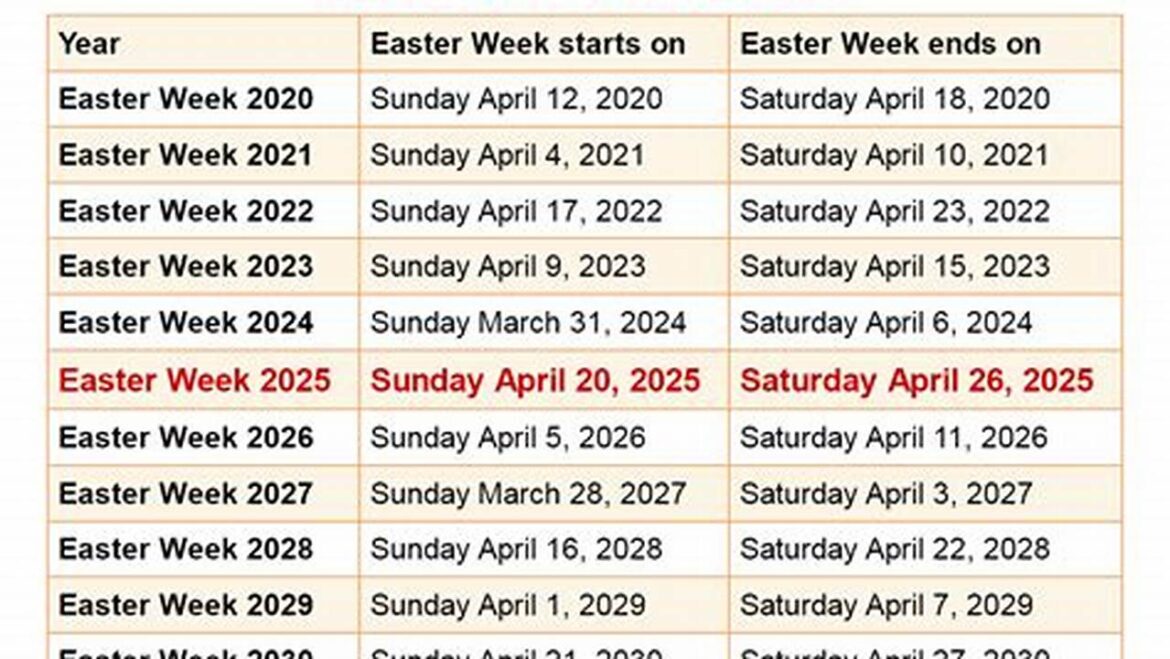Each year, as spring awakens and transforms the landscape with vibrant blooms, the Christian calendar anticipates a momentous occasion: Easter. This celebration of resurrection and renewal does not merely rest on a fixed date; instead, it ebbs and flows with the cycles of the moon and the shifting rhythms of the seasons. Unraveling the mystery of when Easter occurs requires a thoughtful examination of its historical and ecclesiastical contexts.
The Church has observed Easter Sunday since the end of the second century. The foundational element in determining the date of Easter is the Paschal Full Moon, a notion that links this day with ancient agricultural practices as well as the Jewish calendar. The formula established by the Council of Nicaea in 325 AD dictates that Easter is celebrated on the first Sunday following the first full moon after the vernal equinox, which is conventionally fixed on March 21. This formulation produces a window of dates for Easter that spans from March 22 to April 25, crafting a peculiar rhythm that many find both fascinating and confounding.
In essence, the mechanics of the Paschal cycle reflect a broader obsession with celestial phenomena, as humanity seeks to align spiritual observances with natural occurrences. This alignment allows the faithful to experience a profound sense of continuity with creation itself—a resonance that harkens back to the origins of the earth as articulated in Genesis. As one contemplates a sunflower blooming to meet the sun, the intertwining of earthly and divine time becomes acutely apparent.
Yet, Easter’s dating is not merely a scientific endeavor. It is layered with theological implications. The resurrection of Christ is the cornerstone of Christian faith, and its timing—arguably—echoes the themes of death and rebirth prevalent in cultures worldwide. The Church, in its infinite wisdom, looks to harmonize these various threads into a liturgical tapestry that speaks to the human condition. Easter captures the essence of hope amid despair, of life amid death, and is thus a powerful focal point in the Christian narrative.
Moreover, the diverse ecclesiastical traditions around the globe contribute to the kaleidoscope of Easter observance. In the Western Christian tradition—comprising Roman Catholics and Protestants—the Gregorian calendar determines the date, invariably allowing for synchronization in commemorative practices. However, the Eastern Orthodox Church, which adheres to the Julian calendar, often celebrates Easter at a later date due to its distinctive dating system, which results in a rich convergence of traditions—sometimes even leading to simultaneous observances.
For instance, in 2025, Easter will be celebrated on April 20 by Western Christians while Eastern Orthodox believers will observe it later, on April 27. This divergence showcases the plurality of the Christian experience; while the faith rests upon common beliefs, its expressions can take varied forms, illuminating the dynamic relationship between tradition and innovation.
There lies a curious observation around the Easter cycle—the recurring themes of ancient agricultural rituals mirror contemporary celebrations. The concept of rebirth related to the resurrection can be traced through many cultures that celebrate the dawn of spring and the fertility of the earth. In ancient times, agrarian societies marked this transition with feasts and rituals that honor the cycles of growth and renewal. Naturally, this aligns with the Christian understanding of Christ’s resurrection as a new beginning for humanity.
Additionally, various practices tied to Easter reveal deeper theological meanings—such as the decorated eggs symbolizing new life and the arrival of spring, reflecting the ultimate triumph over death. The tradition of dyeing eggs can be seen as an earthly manifestation of the profound spiritual transformation that resonates within believers. It encapsulates the belief that, just as the eggs represent new life, so too does Christ’s resurrection bring forth a new covenant with God.
Certain celebrations and days surrounding Easter also require careful consideration. The days leading up to Easter Sunday—referred to as Holy Week—are replete with significant observances, beginning with Palm Sunday, reflecting Jesus’ entry into Jerusalem. It serves as a poignant reminder of the duality of acclaim and rejection that characterizes the human response to divinity. Maundy Thursday commemorates the Last Supper, characterized by a call to service and humility, while Good Friday marks the day of crucifixion. Each observance illuminates the path to resurrection, thereby highlighting the profound gravity of Easter Sunday itself.
In a broader sense, this intricate calendar system addresses human fascination with time—both in revering the cycles that govern life and in creating commemorative practices that extend beyond the realm of mere chronology. The endeavor to encapsulate divine mysteries within the temporal confines of a calendar unveils the perpetual tension Christians navigate—the dance between the infinite and the finite.
As we ponder the question, “When is Easter each year,” it metamorphoses into an invitation to explore the rich undercurrents of faith, narrative, and historical context that converge within this sacred celebration. Understanding Easter is about more than merely noting dates; it becomes a quest for recognizing transformative experiences—the redemptive journey of every believer infused with the promise of hope arising with the dawn of each Easter morn.
Hence, the question extends beyond calendar queries. It beckons toward engaging with deeper existential themes, as Christians and seekers alike strive to navigate the profound mysteries of life, death, and rebirth through the lens of faith. The date may change, but the significance remains unwavering—the resonance of resurrection echoes through the ages, inviting reflection and renewal in every heart.



